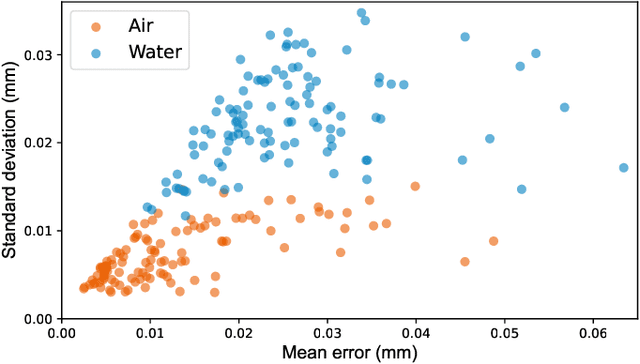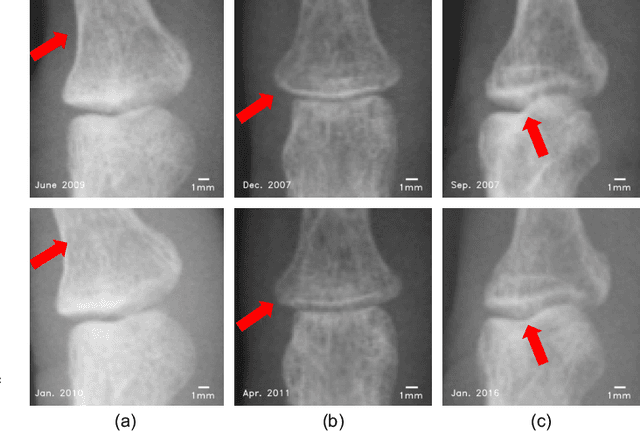Prasoon Ambalathankandy
Layer Separation: Adjustable Joint Space Width Images Synthesis in Conventional Radiography
Feb 04, 2025Abstract:Rheumatoid arthritis (RA) is a chronic autoimmune disease characterized by joint inflammation and progressive structural damage. Joint space width (JSW) is a critical indicator in conventional radiography for evaluating disease progression, which has become a prominent research topic in computer-aided diagnostic (CAD) systems. However, deep learning-based radiological CAD systems for JSW analysis face significant challenges in data quality, including data imbalance, limited variety, and annotation difficulties. This work introduced a challenging image synthesis scenario and proposed Layer Separation Networks (LSN) to accurately separate the soft tissue layer, the upper bone layer, and the lower bone layer in conventional radiographs of finger joints. Using these layers, the adjustable JSW images can be synthesized to address data quality challenges and achieve ground truth (GT) generation. Experimental results demonstrated that LSN-based synthetic images closely resemble real radiographs, and significantly enhanced the performance in downstream tasks. The code and dataset will be available.
BLS-GAN: A Deep Layer Separation Framework for Eliminating Bone Overlap in Conventional Radiographs
Sep 11, 2024Abstract:Conventional radiography is the widely used imaging technology in diagnosing, monitoring, and prognosticating musculoskeletal (MSK) diseases because of its easy availability, versatility, and cost-effectiveness. In conventional radiographs, bone overlaps are prevalent, and can impede the accurate assessment of bone characteristics by radiologists or algorithms, posing significant challenges to conventional and computer-aided diagnoses. This work initiated the study of a challenging scenario - bone layer separation in conventional radiographs, in which separate overlapped bone regions enable the independent assessment of the bone characteristics of each bone layer and lay the groundwork for MSK disease diagnosis and its automation. This work proposed a Bone Layer Separation GAN (BLS-GAN) framework that can produce high-quality bone layer images with reasonable bone characteristics and texture. This framework introduced a reconstructor based on conventional radiography imaging principles, which achieved efficient reconstruction and mitigates the recurrent calculations and training instability issues caused by soft tissue in the overlapped regions. Additionally, pre-training with synthetic images was implemented to enhance the stability of both the training process and the results. The generated images passed the visual Turing test, and improved performance in downstream tasks. This work affirms the feasibility of extracting bone layer images from conventional radiographs, which holds promise for leveraging bone layer separation technology to facilitate more comprehensive analytical research in MSK diagnosis, monitoring, and prognosis. Code and dataset will be made available.
Halo Reduction in Display Systems through Smoothed Local Histogram Equalization and Human Visual System Modeling
Feb 09, 2024


Abstract:Halo artifacts significantly impact display quality. We propose a method to reduce halos in Local Histogram Equalization (LHE) algorithms by separately addressing dark and light variants. This approach results in visually natural images by exploring the relationship between lateral inhibition and halo artifacts in the human visual system.
A Psychological Study: Importance of Contrast and Luminance in Color to Grayscale Mapping
Feb 07, 2024



Abstract:Grayscale images are essential in image processing and computer vision tasks. They effectively emphasize luminance and contrast, highlighting important visual features, while also being easily compatible with other algorithms. Moreover, their simplified representation makes them efficient for storage and transmission purposes. While preserving contrast is important for maintaining visual quality, other factors such as preserving information relevant to the specific application or task at hand may be more critical for achieving optimal performance. To evaluate and compare different decolorization algorithms, we designed a psychological experiment. During the experiment, participants were instructed to imagine color images in a hypothetical "colorless world" and select the grayscale image that best resembled their mental visualization. We conducted a comparison between two types of algorithms: (i) perceptual-based simple color space conversion algorithms, and (ii) spatial contrast-based algorithms, including iteration-based methods. Our experimental findings indicate that CIELAB exhibited superior performance on average, providing further evidence for the effectiveness of perception-based decolorization algorithms. On the other hand, the spatial contrast-based algorithms showed relatively poorer performance, possibly due to factors such as DC-offset and artificial contrast generation. However, these algorithms demonstrated shorter selection times. Notably, no single algorithm consistently outperformed the others across all test images. In this paper, we will delve into a comprehensive discussion on the significance of contrast and luminance in color-to-grayscale mapping based on our experimental results and analysis.
A Deep Registration Method for Accurate Quantification of Joint Space Narrowing Progression in Rheumatoid Arthritis
Apr 27, 2023



Abstract:Rheumatoid arthritis (RA) is a chronic autoimmune inflammatory disease that results in progressive articular destruction and severe disability. Joint space narrowing (JSN) progression has been regarded as an important indicator for RA progression and has received sustained attention. In the diagnosis and monitoring of RA, radiology plays a crucial role to monitor joint space. A new framework for monitoring joint space by quantifying JSN progression through image registration in radiographic images has been developed. This framework offers the advantage of high accuracy, however, challenges do exist in reducing mismatches and improving reliability. In this work, a deep intra-subject rigid registration network is proposed to automatically quantify JSN progression in the early stage of RA. In our experiments, the mean-square error of Euclidean distance between moving and fixed image is 0.0031, standard deviation is 0.0661 mm, and the mismatching rate is 0.48\%. The proposed method has sub-pixel level accuracy, exceeding manual measurements by far, and is equipped with immune to noise, rotation, and scaling of joints. Moreover, this work provides loss visualization, which can aid radiologists and rheumatologists in assessing quantification reliability, with important implications for possible future clinical applications. As a result, we are optimistic that this proposed work will make a significant contribution to the automatic quantification of JSN progression in RA.
A Sub-pixel Accurate Quantification of Joint Space Narrowing Progression in Rheumatoid Arthritis
May 19, 2022



Abstract:Rheumatoid arthritis (RA) is a chronic autoimmune disease that primarily affects peripheral synovial joints, like fingers, wrist and feet. Radiology plays a critical role in the diagnosis and monitoring of RA. Limited by the current spatial resolution of radiographic imaging, joint space narrowing (JSN) progression of RA with the same reason above can be less than one pixel per year with universal spatial resolution. Insensitive monitoring of JSN can hinder the radiologist/rheumatologist from making a proper and timely clinical judgment. In this paper, we propose a novel and sensitive method that we call partial image phase-only correlation which aims to automatically quantify JSN progression in the early stages of RA. The majority of the current literature utilizes the mean error, root-mean-square deviation and standard deviation to report the accuracy at pixel level. Our work measures JSN progression between a baseline and its follow-up finger joint images by using the phase spectrum in the frequency domain. Using this study, the mean error can be reduced to 0.0130mm when applied to phantom radiographs with ground truth, and 0.0519mm standard deviation for clinical radiography. With its sub-pixel accuracy far beyond manual measurement, we are optimistic that our work is promising for automatically quantifying JSN progression.
A color temperature-based high-speed decolorization: an empirical approach for tone mapping applications
Aug 31, 2021Abstract:Grayscale images are fundamental to many image processing applications like data compression, feature extraction, printing and tone mapping. However, some image information is lost when converting from color to grayscale. In this paper, we propose a light-weight and high-speed image decolorization method based on human perception of color temperatures. Chromatic aberration results from differential refraction of light depending on its wavelength. It causes some rays corresponding to cooler colors (like blue, green) to converge before the warmer colors (like red, orange). This phenomena creates a perception of warm colors "advancing" toward the eye, while the cool colors to be "receding" away. In this proposed color to gray conversion model, we implement a weighted blending function to combine red (perceived warm) and blue (perceived cool) channel. Our main contribution is threefold: First, we implement a high-speed color processing method using exact pixel by pixel processing, and we report a $5.7\times$ speed up when compared to other new algorithms. Second, our optimal color conversion method produces luminance in images that are comparable to other state of the art methods which we quantified using the objective metrics (E-score and C2G-SSIM) and a subjective user study. Third, we demonstrate that an effective luminance distribution can be achieved using our algorithm by using global and local tone mapping applications.
 Add to Chrome
Add to Chrome Add to Firefox
Add to Firefox Add to Edge
Add to Edge